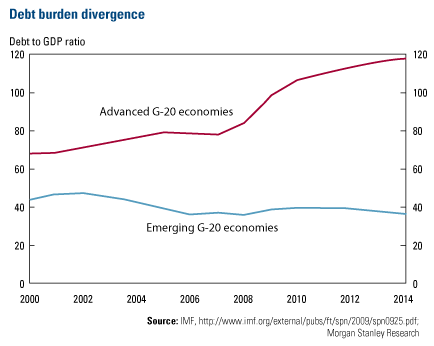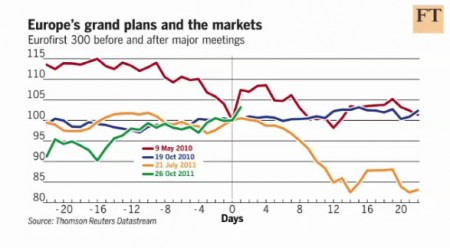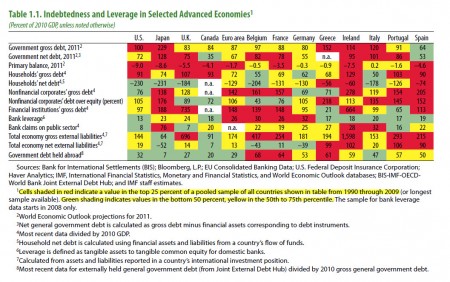Home » debt crisis (Page 2)
Category Archives: debt crisis
What’s Euro’s endgame?
Chris Wood shares his insights on what’s likely the endgame of European sovereign debt crisis.
He predicts it will be either a move from monetary union to fiscal union, or a complete breakdown of the Euro. He thinks the first scenario is more likely and Germany will eventually budge.
Then, Jim Rogers comes in with his thoughts:
Italy in trouble…
According to WSJ, less than two weeks after European leaders unveiled an agreement that was designed to bolster confidence in the region, the yield on Italy’s 10-year debt drew close to the 7% mark, a line in the sand of both practical and psychological importance to the market.
[singlepic id=9 w=400 h=300 float=]
Psychologically, 7% has become a beacon due to the fact that Greece, Portugal and Ireland each sought bailouts soon after their debt reached these levels. While analysts said it is too simplistic to say that Italy will be forced to ask for support if its 10-year debt yields 7%, they said the recent selloff is taking the country to the tipping point.
A sharp slide in bond prices pushed yields to their highest levels since the inception of the euro. The two-year yield rose a staggering 0.60 percentage points to 6.04% while the five-year yield climbed 0.37 percentage points to 6.56%.The 10-year yield was up 0.27 percentage points to 6.60%, having hit a new high of 6.62% earlier Monday.
[singlepic id=10 w=500 h=375 float=]
Update 1 (on Nov. 10, 2011)
Italian gov. bond yields continues to soar, now above 7% threshold. See the chart from WSJ below:
[singlepic id=13 w=400 h=300 float=]
It seemed that Europe is gradually approaching its own Lehman moment. What’s different, compared to previously trouble of other smaller PIIGS, is that the latest escalation fed fears that the euro-zone debt crisis is starting down its most perilous path: going from a storm raging among small countries at Europe’s fringe to one that strikes a major economic power.
Also, Italy’s debt load of €1.9 trillion ($2.6 trillion) is the second largest in Europe, behind Germany’s, and the fourth largest in the world. Next year, more than €300 billion of debt comes due, and Italy must continually tap markets to refinance it.
Debt Snapshot
A snapshot of debt (government, household and corporate) of world’s advanced economies. For a hint of what’s likely to be the end of the game, read my previous post, “The moral breakdown“.
(click to enlarge; source: IMF)
Europe’s debt disease
The following graph was taken out from a recent report on Europe’s debt trajectory by GMO’s Rich Mattione. It pretty much summarizes the current dire situation in Europe.
Greece is not the only country in trouble. Italy is the real threat to the stability of Europe. If Italy falls, Europe falls.
Germany and France, the two largest economies in Europe, are relatively better positioned, but their government-debt-to-GDP ratios, 83% and 82%, respectively, will seriously constrain their ability to bail out the PIIGS (Portugal, Italy, Ireland, Greece and Spain). In contrast, Scandinavian countries enjoy the strongest position in all developed countries, with the debt-to-GDP ratio well below 50%.
[singlepic id=8 w=400 h=300 float=]
The impact of a US debt downgrade
Friday’s downgrade by S&P of the US sovereign debt, from AAA to AA+, was an extraordinary event in modern finance. As reported by WSJ, the is the first time the US government debt lost its AAA credit rating in more than 70 years.
What does this mean for the US and world economy? Here is an insightful interview of Nouriel Roubini (aka Dr. Doom), Christina Romer (former Chairman of President’s Council of Economic Advisors), and Jim Bianco (president of Bianco Research).
US Treasurys are widely held as collateral by many financial institutions around the world. The biggest risk is a sharp fall in value of US Treasurys may trigger another credit dry-up in the financial system. This is perfectly summarized in the following paragraphs in the WSJ piece:
J.P. Morgan Chase & Co. analysts estimate some $4 trillion worth of Treasurys are pledged as collateral by borrowers such as banks and derivatives traders. If that collateral isn’t considered as high quality by lenders, the borrowers could be required to cough up more cash or securities to put the minds of lenders at ease.
That could force investors to sell off other assets to come up with the money. In a worst case scenario, credit markets could seize up, as they did during the Lehman Crisis.
Money market funds held by millions of Americans hold some $1.3 trillion in securities directly or indirectly exposed to Treasury and government agency securities, as well as short-term loans to financial institutions, known as repos, which are backed by Treasurys. Experts say that the downgrade won’t force money market funds to sell. But there are still risks.
If Treasurys tumble in value, funds will be forced to mark down their holdings, raising the potential for some to “break the buck” as the Reserve Primary fund did during the worst of the financial crisis.
Lastly, let’s hope China and Japan won’t sell: a key concern will be whether the appetite for U.S. debt might change among foreign investors, in particular China, the world’s largest foreign holder of U.S. Treasurys. In 1945, foreigners owned just 1% of U.S. Treasurys; today they own a record high 46%, according to research done by Bank of America Merrill Lynch.
In theory, China and the US are on the same boat: a fall in US Treasurys won’t do Chinese any good. But that’s only theory on paper: people do all kinds of things when they panic. Same thing applies to governments. Personally, I think the chance is very slim for Chinese to dump US Treasurys. But always be reminded “what could happen” – Re-watching this 2009 interview of Julian Robertson of Tiger Management will help you appreciate the worst scenario.
Sovereign Debt Quality Divergence
Sovereign debt quality as measured by debt-to-GDP ratio.

(hat tip: US Global Investors)
The Inevitable Endgame
Interview of Chris Wood, top ranked Asian Equities Strategist. He talks about the outlook for China, Europe and the US.
He predicts the inevitable endgame will be a systemic government debt crisis in the Western world.



